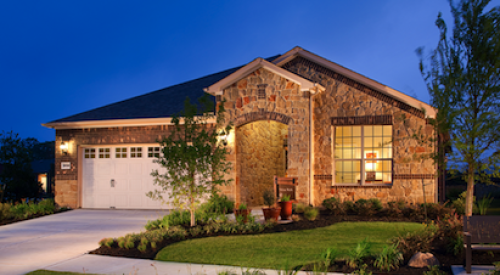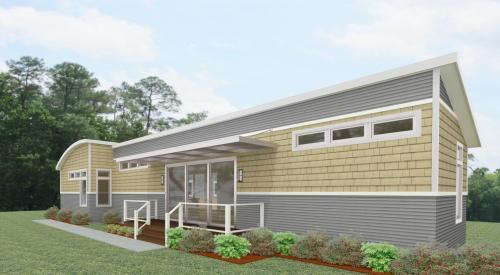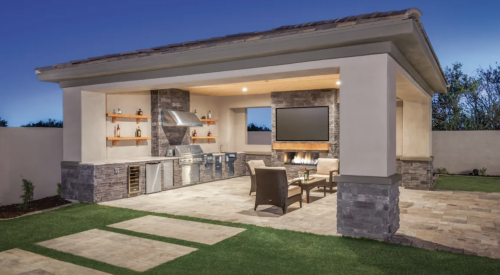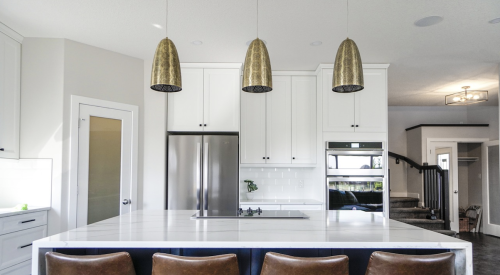One prominent trend of the last few years has been the rise of specialty rooms, which fit into the broader construction category of built-ins. And while elaborate theater rooms and spaces pre-wired for computers and office equipment are key selling points for upscale markets, the rest of the built-in spectrum offers hidden marketing opportunities.
| Computer niches and tech stations for children (above) and family use (below), have become a near necessity in many new homes of today. (Photos courtesy of David McNew) |
"Any type of built, fixed or attached element that takes the place of a piece of furniture, eliminates clutter and makes spaces bigger is a tremendous amenity to buyers," says Dan O’Malley, director of design for the Chicago regional office of Bloodgood Sharp Buster Architects and Planners, Inc.
With many of today’s families having more than one computer, there is a need for more than just a home office and many buyers want to know where they will put their other machines. This has caused builders to use their floor plans more efficiently and divide spaces according to function, instead for purely decorative or dramatic purposes.
"Today’s trend is more toward dividing the spaces into their respective uses," says Carole Lavender of Lavender Design Group in San Antonio, Texas. "For instance, what was once a volume ceiling over the foyer is now a computer niche."
Fireplaces and media centers are more optional built-ins, often becoming the focal point or establishing a decorating theme for family rooms. These also can be used as room dividers, with three-sided or peninsula fireplaces separating family rooms from dining or kitchen areas, and sleeping areas from sitting areas in master suites.
"Bookcases can also be used as room dividers," says O’Malley. "They may only be around four feet high, but they provide a nice visual break."
Different Markets, Different Trends
Like most residential building trends, the recent surge of built-ins began in California and the Southwest, and O’Malley says that region is where the grander master suites, complete with juice bars and mini breakfast areas, are more prevalent. He also states that media centers are often the focal points in multi-family housing in the Southeast, becoming the centers around which residents entertain guests.
In the Midwest, media centers are creeping into spaces other than just the family room. "We’re taking out a few closets and putting in media niches in master bedrooms and dens--especially in our high-rise projects," says Nancy Tybor, manager of MCL Companies’ design center in Chicago.
| Integrated furniture-grade media centers, complete with glass shelving and accent lighting, are among today’s most popular built-ins. (Photo courtesy Bloodgood Sharp Buster) |
She also states that in their infill townhomes, where many residents are two-income families, computer niches in the kitchen are an extremely popular feature. "These families want an area where their kids can work or play on the computer while the parents prepare the meals," says Tybor. "This helps them spend much more time together."
Some trends defy geographical boundaries and are influenced more by buyer demographics. First-time buyers often do not have much furniture, so bookcases, niches and storage areas are a great value-added feature for them. "First-time buyers really see built-ins as a piece of free furniture," says Lavender.
Many first-time buyers are also young couples who are just beginning as a family, so built-ins in the children’s rooms are another way to capture their attention. Toyboxes, storage areas and even more elaborately themed play areas incorporated into kids’ rooms are growing in popularity. "Concentrating on the children’s rooms is a great way attract more first-time buyers. Builders should look at this as helping young families make their dreams come true," says Lita Dirks of Lita Dirks & Co., a merchandising firm out of Englewood, Colo.
Move-up buyers and empty nesters typically have more money to spend on their homes. Built-ins should reflect this by providing a more customized look with fine detailing. Because this market can typically afford more and better high-tech components, and these families typically have older children, media centers are even more vital in this market than others.
Empty nesters appreciate more storage and display niches than other markets because they have accumulated more valuables and mementos. Common built-ins for them include art niches and bookshelves around fireplaces.
| Utilizing nooks and crannies created by the architecture of homes creates “wow factors,” allowing builders to better capture buyers’ attention. (Top photo: Waterford Quality Homes. Left photo: Bloodgood Sharp Buster) |
"We’re building a lot of cabinets in dining rooms so empty nesters can display their fine china," says Tybor. "One of the most important things to remember is to match these built-ins with the custom kitchen cabinetry, which is often furniture-grade." Because hardwoods are growing in popularity as cabinet material, they are also the most popular materials for built-ins, particularly maple, oak and cherry.
Perhaps the most important thing to consider when designing built-ins is the floor plan and traffic patterns of each home. "Don’t put a tech station in a narrow hallway," says O’Malley. "And always be aware of how the addition of a built-in will affect furniture placement."
Dirks points out that home offices demand some careful planning unique to their function. "The shelves and work surfaces should have the depth to hold personal computers, kneespace for people to sit at them, and enough electrical outlets and wiring strategically placed to accommodate all peripheral equipment."
Lavender recommends that builders should search for areas that have been traditionally overlooked to find built-in opportunities. Staircases are a perfect example, as the area underneath can be used as a wine grotto or tuck-in storage, landings can be turned into cozy sitting areas, or the top of the staircase can be turned into a library loft with a few simple bookcases and a window seat.
O’Malley says that storage elements often make the simplest built-ins, yet are immensely appreciated by buyers. "A simple mud room with a wall of lockers is an easy way to give buyers a great value-added feature. Good efficient design just never goes out of style."
"People aren’t really demanding built-ins yet," says Lavender, "but builders who use them wisely will definitely have a competitive edge."











